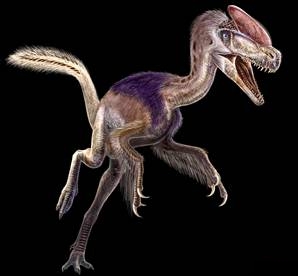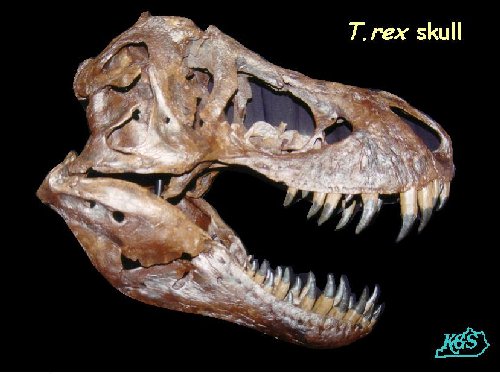Fossils found in China may give clues to the evolution of Tyrannosaurus rex.
 Uncovered near the city of Jiayuguan, the fossil finds come from a novel tyrannosaur dubbed Xiongguanlong baimoensis.
Uncovered near the city of Jiayuguan, the fossil finds come from a novel tyrannosaur dubbed Xiongguanlong baimoensis.
The fossils date from the middle of the Cretaceous period, and may be a "missing link", tying the familiar big T rex to its much smaller ancestors.
The fossils show early signs of the features that became pronounced with later tyrannosaurs.
 Paleontological knowledge about the family of dinosaurs known as tyrannosaurs is based around two distinct groups of fossils from different parts of the Cretaceous period, which ran from approximately 145 to 65 million years ago.
Paleontological knowledge about the family of dinosaurs known as tyrannosaurs is based around two distinct groups of fossils from different parts of the Cretaceous period, which ran from approximately 145 to 65 million years ago.
One group dates from an early part of the period, the Barremian, and the other is from tens of millions of years later.
Before now it has been hard for palaeontologists to trace the lineage from one group to the other.
 "We've got a 40-50 million year gap in which we have very little fossil record," said Peter Makovicky, associate curator at the Field Museum in Chicago, who helped to lead the US/Chinese team that uncovered the fossil.
"We've got a 40-50 million year gap in which we have very little fossil record," said Peter Makovicky, associate curator at the Field Museum in Chicago, who helped to lead the US/Chinese team that uncovered the fossil.
But, he said, X baimoensis was a "nice link" between those two groups.
"We're filling in that part of the fossil record," he said.
Writing in the Royal Society's journal Proceedings B, Dr Makovicky and colleagues suggest that X baimoensis is a "phylogenetic, morphological, and temporal link" between the two distinct groups of tyrannosaurs.
 The fossil has some hallmarks of large tyrannosaurs such as a boxy skull, reinforced temple bones to support large jaw muscles, modified front nipping teeth and a stronger spine to support a large head.
The fossil has some hallmarks of large tyrannosaurs such as a boxy skull, reinforced temple bones to support large jaw muscles, modified front nipping teeth and a stronger spine to support a large head.
But it also shows features absent from older tyrannosaurs, such as a long thin snout.
An adult would have stood about 1.5m tall at the hip and weighed about 270kg. By contrast, an adult T rex was about 4m tall at the hip and weighed more than 5 tonnes.
 The same edition of Proceedings B features papers about two other sets of dinosaur fossils.
The same edition of Proceedings B features papers about two other sets of dinosaur fossils.
One discovery was made in China by many of the palaeontologists who found the tyrannosaur. The samples found in the Yujingzi Basin came from a dinosaur that resembled the modern ostrich.
While many of these ornithomimosaurs have been found before, analysis of the bones of the new species, dubbed Beishanlong grandis, suggest it was one of the biggest.
The specimen found by the palaeontologists was thought to be 6m tall and weigh about 626kg.
Alongside in Proceedings B was work on the remains of a duck-billed dinosaur found in Uzbekistan called Levnesovia transoxiana.
Analysis of the fossils, by Hans-Dieter Sues of the Smithsonian in Washington and Alexander Averianov of the Russian Academy of Sciences, may shed light on the waves of expansion hadrosaurs undertook during the late Cretaceous.
 Uncovered near the city of Jiayuguan, the fossil finds come from a novel tyrannosaur dubbed Xiongguanlong baimoensis.
Uncovered near the city of Jiayuguan, the fossil finds come from a novel tyrannosaur dubbed Xiongguanlong baimoensis.The fossils date from the middle of the Cretaceous period, and may be a "missing link", tying the familiar big T rex to its much smaller ancestors.
The fossils show early signs of the features that became pronounced with later tyrannosaurs.
 Paleontological knowledge about the family of dinosaurs known as tyrannosaurs is based around two distinct groups of fossils from different parts of the Cretaceous period, which ran from approximately 145 to 65 million years ago.
Paleontological knowledge about the family of dinosaurs known as tyrannosaurs is based around two distinct groups of fossils from different parts of the Cretaceous period, which ran from approximately 145 to 65 million years ago.One group dates from an early part of the period, the Barremian, and the other is from tens of millions of years later.
Physical form
Before now it has been hard for palaeontologists to trace the lineage from one group to the other.
 "We've got a 40-50 million year gap in which we have very little fossil record," said Peter Makovicky, associate curator at the Field Museum in Chicago, who helped to lead the US/Chinese team that uncovered the fossil.
"We've got a 40-50 million year gap in which we have very little fossil record," said Peter Makovicky, associate curator at the Field Museum in Chicago, who helped to lead the US/Chinese team that uncovered the fossil.But, he said, X baimoensis was a "nice link" between those two groups.
"We're filling in that part of the fossil record," he said.
Writing in the Royal Society's journal Proceedings B, Dr Makovicky and colleagues suggest that X baimoensis is a "phylogenetic, morphological, and temporal link" between the two distinct groups of tyrannosaurs.
 The fossil has some hallmarks of large tyrannosaurs such as a boxy skull, reinforced temple bones to support large jaw muscles, modified front nipping teeth and a stronger spine to support a large head.
The fossil has some hallmarks of large tyrannosaurs such as a boxy skull, reinforced temple bones to support large jaw muscles, modified front nipping teeth and a stronger spine to support a large head.But it also shows features absent from older tyrannosaurs, such as a long thin snout.
An adult would have stood about 1.5m tall at the hip and weighed about 270kg. By contrast, an adult T rex was about 4m tall at the hip and weighed more than 5 tonnes.
Wider net
 The same edition of Proceedings B features papers about two other sets of dinosaur fossils.
The same edition of Proceedings B features papers about two other sets of dinosaur fossils.One discovery was made in China by many of the palaeontologists who found the tyrannosaur. The samples found in the Yujingzi Basin came from a dinosaur that resembled the modern ostrich.
While many of these ornithomimosaurs have been found before, analysis of the bones of the new species, dubbed Beishanlong grandis, suggest it was one of the biggest.
The specimen found by the palaeontologists was thought to be 6m tall and weigh about 626kg.
Alongside in Proceedings B was work on the remains of a duck-billed dinosaur found in Uzbekistan called Levnesovia transoxiana.
Analysis of the fossils, by Hans-Dieter Sues of the Smithsonian in Washington and Alexander Averianov of the Russian Academy of Sciences, may shed light on the waves of expansion hadrosaurs undertook during the late Cretaceous.
No comments:
Post a Comment